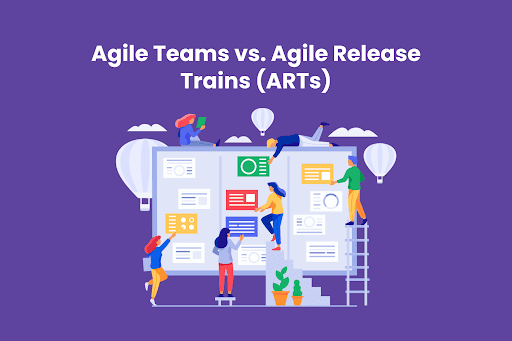The Agile approach has become a mainstay for teams trying to produce value fast and effectively in the ever-changing world of project management and software development. Scaling Agile practises becomes necessary as organisations develop and projects get more complicated. This is where the Scaled Agile Framework (SAFe)-based Leading SAFe Course comes in. In this blog, we’ll look at the fundamental differences between Agile teams and Agile Release Trains (ARTs) inside the SAFe architecture and how organisations may choose the best method for their scaling requirements. This will also help you understand the differences between Agile vs Scaled Agile Framework better.
Table of Contents
- Agile Framework vs. Scaled Agile Framework
- Agile Teams: The Building Blocks
- Agile Release Trains (ARTs): Scaling Agile for Enterprises
- Choosing Between Agile Teams and Agile Release Trains
- Conclusion
Agile Framework vs. Scaled Agile Framework
Before we get into the specifics of Agile Teams and Agile Release Trains, let’s first define Agile and the Scaled Agile Framework.
Agile is a development process that emphasises iterative development, teamwork, and client input in order to produce value more quickly. Agile Teams, which are cross-functional groups responsible for delivering a single piece of functionality, are at the centre of this strategy. They concentrate on continuous development and work in small iterations (sprints).
The Scaled Agile Framework (SAFe), on the other hand, is a framework meant to extend Agile concepts to big organisations, enabling them to efficiently scale Agile practises. To manage the work of many Agile teams, align them with business goals, and assure synchronised delivery, SAFe introduces the notion of Agile Release Trains (ARTs).
Agile Teams: The Building Blocks
Agile Teams are the foundational elements of Agile techniques. They are often made up of 5-9 people with varied skill sets, including developers, testers, designers, and business analysts. These teams are self-organising, which means they have the authority to make choices about their work.
The following are some of the important features of Agile Teams:
- Cross-Functional: Agile Teams are interdisciplinary, bringing together people with diverse abilities to guarantee that all elements of development are addressed, from coding to testing to design.
- Empowered: These teams have the authority to make choices about the scope, timeline, and design of the work they do. This empowers team members to take responsibility and accountability.
- Agile Teams work in short iterations (often 2-4 weeks) to create a potentially shippable product increment at the conclusion of each iteration. This method enables quick feedback and customisation.
- Continuous Improvement: Agile Teams adhere to the concepts of continuous improvement, always looking for ways to better their processes and create higher-quality products.
Agile Release Trains (ARTs): Scaling Agile for Enterprises
Agile Release Trains (ARTs) are used when an organisation outgrows the capacity of individual Agile Teams or needs to coordinate activities across numerous teams to accomplish greater objectives. SAFe’s central idea is ARTs, which offer a framework for organising and synchronising the work of numerous Agile Teams.
The following are the key features of Agile Release Trains:
- An ART is made up of numerous Agile Teams that work together to achieve a shared goal or product. These teams often work on distinct components of a bigger solution while remaining focused on the same business objectives.
- Programme Increment (PI): ARTs work on a set time frame known as the Programme Increment (PI), which normally lasts 8-12 weeks. Teams plan, execute, and provide value throughout each PI, ensuring that progress is quantifiable and predictable.
- The PI Planning meeting is one of the main activities in SAFe when all teams within an ART get together to plan the work for the forthcoming Programme Increment. This event ensures that efforts across teams are aligned and synchronised.
- Each ART is headed by a Release Train Engineer, who is responsible for encouraging collaboration, clearing obstructions, and keeping the train on track. The RTE is important to the success of the ART.
Choosing Between Agile Teams and Agile Release Trains
After discussing the characteristics of Agile Teams and Agile Release Trains, the issue of which strategy is best for your organisation emerges. The solution is determined by your unique scalability requirements and organisational structure.
Agile Teams are excellent for:
- Smaller organisations or initiatives with a lower level of complexity.
- Situations in which teams may function autonomously without much coordination.
- Projects that need rapid adaptation to changing requirements.
Agile Release Trains, on the other hand, are a better match for:
- Large organisations with several Agile Teams working on related projects.
- Projects with strong team interdependence that need synchronisation.
- Organisations that want to integrate their development activities with their business goals and get portfolio-level visibility.
It is critical to highlight that SAFe gives flexibility in determining the appropriate amount of scalability. Organisations may start with Agile Teams and then progress to ARTs as they expand and require more coordination and alignment.
Conclusion
Understanding the distinction between Agile Teams and Agile Release Trains (ARTs) in the realm of Agile techniques and the Scaled Agile Framework (SAFe) is critical for organisations looking to scale their Agile practices efficiently. While Agile Teams are the fundamental units responsible for delivering value via iterative development, ARTs offer the framework required for big organisations to synchronise efforts and align with strategic objectives.
Whether you pick Agile Teams or go on the adventure of constructing Agile Release Trains, the key is to choose the strategy that best meets the size, complexity, and growth needs of your organisation. The Leading SAFe Course provides essential insights and direction on applying SAFe principles, assisting organisations in navigating the complex Agile and Scaled Agile Framework environment.


















